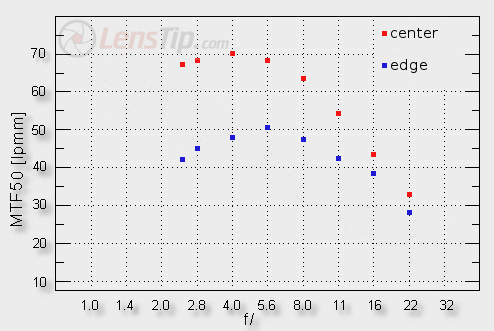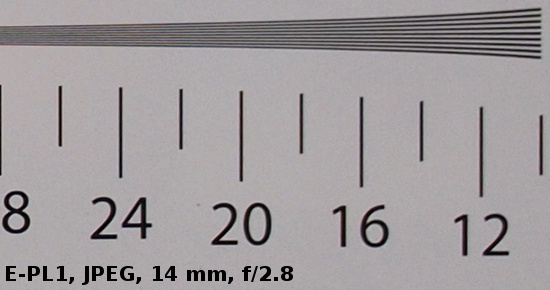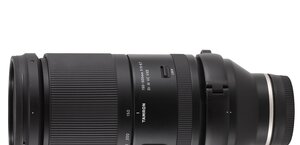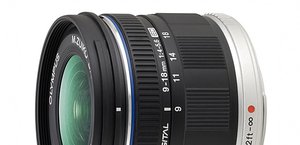Panasonic G 14 mm f/2.5 ASPH.
4. Image resolution
The measurement margin of error for the values, presented on the graph below, ranged from 0.6 to 1.5 lpmm.

Please Support UsIf you enjoy our reviews and articles, and you want us to continue our work please, support our website by donating through PayPal. The funds are going to be used for paying our editorial team, renting servers, and equipping our testing studio; only that way we will be able to continue providing you interesting content for free. |
- - - - - - - - - - - - - - - - - - - - - - - - - - - - - - - - - - - - - - - - - - - - - - - -
The results reached by the Panasonic 2.5/14 bring mixed feelings. Certainly we can find a lot of bright spots and the lens should be praised for them. Here I can mention the performance at the maximum relative aperture in the frame centre, where the lens gives very sharp images, high above the decency level which is set near 44-45 lpmm. Unfortunately the fastness of the lens doesn’t allow it to achieve such high MTF values as the 1.7/20 model. That latter could get to 75 lpmm whereas the device tested here reaches just 70 lpmm. As we mentioned it before, it is due to worse fastness. The 4/3 system lenses perform the best near f/4.0 aperture. When it comes to the Panasonic 2.5/14, that value is in the distance of only 1.3 EV from the maximum relative aperture so the influence of optical aberrations is still noticeable. On further stopping down that influence decreases but then diffraction makes itself felt.
A small 4/3 system sensor makes it possible to construct wide-angle lenses which fare really great on the edge of the frame. They are noticeably bigger, though, not like the “pancake” tested here. Most probably these small dimensions are the reason why the image quality on the edge of the frame doesn’t impress us much. Firstly it really lags behind the performance in the frame centre; what’s more at the maximum relative aperture we land a bit below the decency level. Fortunately it’s enough to stop the aperture down to f/2.8 to make this problem disappear. On further stopping down the image quality improves too but very slowly. The best results the lens reaches near f/5.6 where it exceeds a bit the level of 50 lpmm. It’s almost 20 lpmm lower than in the frame centre, though…
To sum up the lens deserves an excellent achievement grade for the frame centre resolution but for the performance on the edge I would give it only a pass mark plus.
At the end of this chapter we present the crops of our test chart, taken from JPEG files which were saved along RAW files. We would like to remind here that the E-PL1, even if set on the lowest level of sharpening (which is called –2 in the menu), sharpens JPEG quite significantly (the MTFs measured on JPEGs are about 40% higher than those measured on corresponding RAW files).
 |






